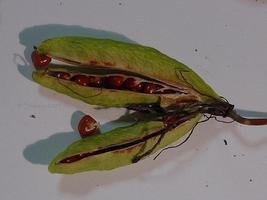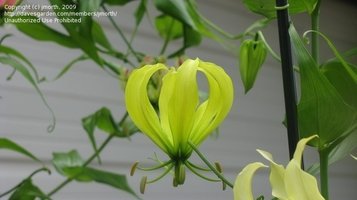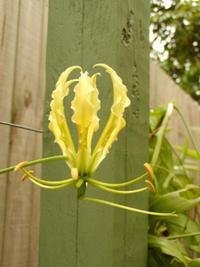





Once in a while a flower grabs the gardener's attention and screams, "Buy me, buy me!" That's the way the glory lily did me when I saw its picture on a bulb bin at a garden center one spring several years ago. I've never regretted the demand, for the flowers delight me with glorious blooms every summer.
Other gardeners will understand why I found it irresistible when they see it in bloom. Reminiscent of flames, the undulating petals of the down-facing blooms sweep outward and upward, looking somewhat like a lily turned inside out, or maybe the way the hair sweeps back from the face when one is racing down the interstate in a convertible with the top down. Prominent stamens splay out from the center and attempt to follow the recurving petals' backward arc.
Lance-shaped leaves of the gloriosa lily are unusual, too. Grasping tendrils develop at the tips of leaves and clasp onto any nearby object, including shrubs, fences, trellises, or even its own stem. The tendrils are sturdy and firm enough to pull the stem up to its six-foot height if given a support upon which to climb.
 Gloriosa superba, sometimes called climbing lily, flame lily, gloriosa lily, or glory lily, is an unusual member of the lily family (Liliaceae). Plants grow from L- or V-shaped tubers that travel slowly underground. They are native to the tropical jungles of Africa.
Gloriosa superba, sometimes called climbing lily, flame lily, gloriosa lily, or glory lily, is an unusual member of the lily family (Liliaceae). Plants grow from L- or V-shaped tubers that travel slowly underground. They are native to the tropical jungles of Africa.
Be careful where you plant them, and make sure that the tubers face the direction you want them to move. Each year the old tuber dies and a new one grows to take its place, which causes the location of the tuber to change over a few years. You may find that your glory lilies have moved to the neighbor's yard, or they may progress from your support out into the lawn. Because of this habit, the lilies sometimes need to be dug and reset.
Culture
Glory lilies prefer well-drained, organic, moisture-retentive soil and full sun to partial shade. Mine have found a perfect home underneath the banana shrub (Magnolia figo) that grows in the front yard. Passersby want to know what kind of shrub bears those beautiful flowers. They don't realize that the glory lilies are underneath the shrub and have climbed upward toward the sun so that only the flowers are showing on top.
Dependably hardy only in the tropical south, glory lily has performed well in my zone 8b garden for many years. Obviously, it is protected underneath the banana shrub. A neighbor has a beautiful display on a chain link fence. In areas where the lilies are not hardy, the tubers can be dug in fall and stored in a frost-free place during the cold months.
 Propagation is by division of tubers and by seeds. Plant seeds in spring, but allow several months for them to germinate. Young plants will bloom in about three years.
Propagation is by division of tubers and by seeds. Plant seeds in spring, but allow several months for them to germinate. Young plants will bloom in about three years.
Kinds
Several different kinds of glory lilies are available. The cultivar 'Lutea' is all yellow with slender, frilled petals, and 'Citrina' is yellow with dark red markings. A dwarf form is appropriately called 'Nana'. G. x greenii ‘Wilhelmina Green' grows about three to four feet tall and sports exotic lemon-yellow flowers with swept-back petals that are not as frilled as 'Rothschildiana'. The species Gloriosa carsonii has mahogany petals edged in golden yellow, with a greenish center, and grows to about six feet tall.


 Gloriosa greenii
Gloriosa carsonii
Gloriosa lutea
Gloriosa greenii
Gloriosa carsonii
Gloriosa lutea
Gloriosa superba is exported from India, where collection of seeds and roots for market has caused it to become endangered in its native habitat. It has become so threatened in Patalkot Valley of southern India that a whole series of traditional medicines used for eons is in danger of being lost to the tribes who live there and to the pharmaceutical industry in India.
Gloriosa lily is the national flower of Zimbabwe. It has many medicinal uses, but all parts of the plant contain the toxic alkaloids colchicine and gloriosine as well as other compounds. Juice of the leaves has been used as an ingredient in arrow poisons. The lesson is this: enjoy this beautiful flower in your garden, but refrain from ingesting plant parts in any way. Many plants are poisonous, and we learn not to eat any plant unless it is known to be edible.
Thanks to GardenGuyKin, Jmorth, Brugmansia, Floridian, and Hidden Lily for the use of their images.Copyright © www.100flowers.win Botanic Garden All Rights Reserved